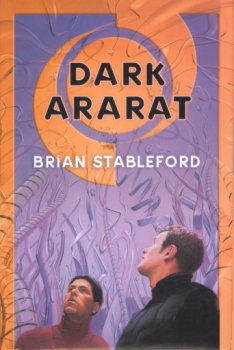Review by Ian Braidwood
Cast of Characters:
Mathew Fleury, Dr Nita Brownell, Inspector Vince Solari,
Franz Leitz, Mr Riddell, Konstantin Milyukov, Andrei
Lityanski, Shen Chin Che, Ikram Mohammed, Lynn Gwyer,
Tang Dinh Quan, Godert Kreifmann, Maryanne Hyder, Dulcie
Gherardesca and Rand Blackstone.
This review of Dark Ararat is unique, because
it is the only review of the book as the author intended
it. Tor have cut nearly two complete chapters from their
edition and Brian has kindly given them to me to publish
here so you can see the difference. To restore the novel,
insert the prologue at the start, the dream sequence
after the first paragraph of chapter 37 and then ignore
the epilogue from the Tor version.
Brian cut his teeth on the ecological mystery
in the early seventies, practically inventing the form
and developing it up to his break and The Gates of Eden.
When he came back after his SF hiatus, he tended to write
different types of books and his writing had improved so
markedly that it became an interesting question as to
what an eco-mystery would be like if he wrote one now.
Well, Dark Ararat is the answer to that
question and Brian has taken the form forward
considerably.
There are numerous questions in the book,
which are necessarily addressed by any serious attempt at
writing about space colonisation; they are simply
contingent to the situation. For instance, whether life
forms can be carbon based and if so, whether DNA is
necessary, or could some other replicator molecule
organise proteins well enough to build multicellular
organisms. (This of course presupposes that life has to
be multicellular to be interesting.)
Most SF authors simply brush these aside,
because they want to tell an adventure and anyway, these
are complex issues, which most SF authors (being
physicists by persuasion) aren't competent to address.
There were of course, the Murasaki stories by
Greg Bear, David Brin etc, but these were deliberately
set on a world as close to Earth as could reasonably be
expected if the universe were being generous. They
assumed that DNA was the genetic molecule, though they
did introduce new bases, giving the replicator the
ability to synthesise unique proteins.
Brian hasn't allowed himself such luxuries,
addressing the question of DNA's prevalence and opting
for a completely different genetic molecule, which builds
organisms in a radically different way.
It is of course, the point of the novel to
unravel these mysteries, so I'll go no further in this
direction, except to say that Dark Ararat undermines many
assumptions which other SF authors don't even realise
they are making.
The situation which Mathew Fleury finds
aboard the starship Hope is a complicated one. Not only
have the crew staged a communist revolution and are in a
state of civil war, but down on Ararat/Tyre there has
been a murder, so the crew have woken Inspector Vince
Solari at the same time to investigate this crime.
The hibernation process isn't cost free, so
Vince and Mathew have to spend some time reacclimatising,
before they can be sent down to the surface. During this
time, they use film taken from various planetary probes
to have a preliminary look at the life forms, whose least
bizarre characteristic is that they are bright purple.
Also, Mathew makes contact with Shen Chin Che, leader of
the counter revolutionaries.
Down on the surface, the situation is as
complicated as in orbit. An old city has been found and
many of the would be colonists are using this to cover
their anxieties and argue that the humans should withdraw
from the planet.
Vince and Mathew are landed by the old city,
where a small team are investigating the ruins and where
Bernal Delgado's murder was committed. Once there, they
have to confront many problems before Mathew joins a boat
trip down river to find the descendants of the city
builders and finally solve the murder and the mysteries
of Araratian/Tyrian biology.
As you can see from the length, yet
superficiality of this review, Dark Ararat is a dense and
complex novel, which stands testament to Brian's skill as
a writer, because it is also easy to read. This is
intellectual SF that conscientiously avoids glossing over
problems which real colonists will have to face. It
stands too as evidence for the depth and scope of Brian's
intelligence and for the relative paucity of writers who
compose solely for entertainment.
I look forward to being able read all the
Emortality books again at leasure.
A review by Ken Newquist is online HERE
Two more reviews are HERE.
|


